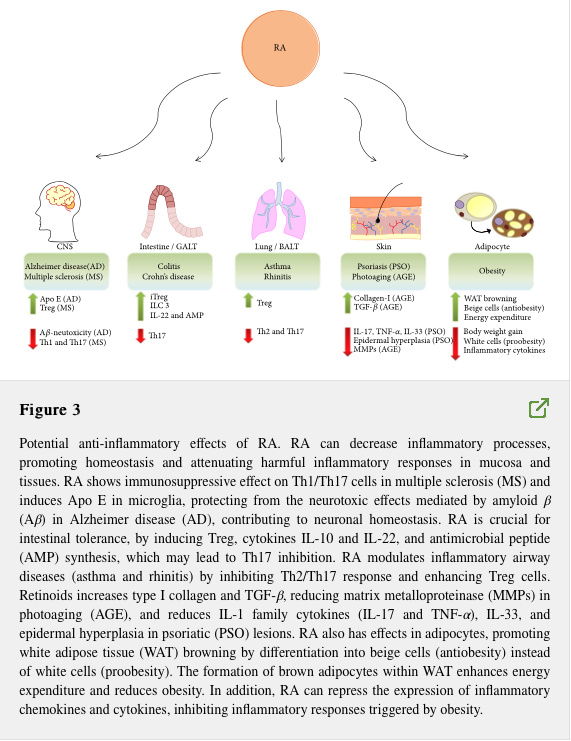
CD is characterized by chronic intestinal inflammation, followed by periodic intervals of remission (Soares-Mota et al., 2015). Part of controlling said inflammation is through lowering the concentration of reactive oxygen species (ROS) along the gastrointestinal tract. Such a process is known to reduce tissue damage associated with CD. Furthermore, as part of a complex of anti-oxidant substance protocols, vitamin A helps down regulate the autoimmune response associated with CD (Soares-Mota et al., 2015). However, accurate determination of retinol levels is a critical first step in such an intervention.

Prior to the research of Soares-Mota et al. (2015), most studies assessed retinol in CD patients via serum retinol levels (SRLs). However, such a test was thought to be limiting as evidence bySoares-Mota et al. (2015) suggested that individuals with CD had SRLs that indicated sufficient levels, yet liver biopsies (where the majority of vitamin A is stored) were low. Soares-Mota et al. (2015) suggested that implementing a relative dose response (RDR), in conjunction to SRLs, would help elicit a more meaningful understanding of retinol levels among those with CD.

The RDR is a non-invasive test that allows for an indirect measurement of vitamin A liver stores. After an initial test of serum retinol is recorded, 2500 IU of retinyl palmitate is orally consumed (Soares-Mota et al., 2015). 5 hours later, a second collection of blood is taken. Results were then placed in the following equation: 5-hour plasma retinol – initial plasma retinol divided by 5-hour plasma retinol concentration x 100 (Gropper, Smith, & Carr, 2018).Results above or equal to 20% would indicate insufficient levels of hepatic vitamin A (Gropper et al., 2018).

33 CD patients and 33 controls underwent a SRL and RDR protocol. Using the SRL protocol, 29% of the CD group and 15% of the control group had hypovitaminosis (vitamin deficiency). Interestingly, when using the RDR, 37% of the CD group and 12% of the control group had decreased retinol stores. Such results indicate that vitamin A deficiency might be higher in CD populations compared to past conclusions using SRL as a stand-alone modality. Ultimately, fasting SRL is likely to underestimate hepatic vitamin A deficiency, since the liver releases its retinol stores to maintain serum levels (Soares-Mota et al., 2015). As such, a higher percentage of individuals with CD are likely to have inadequate vitamin A.
In conclusion, vitamin A plays a critical role managing CD-related intestinal inflammation and tissue damage. However, it is essential that appropriate tests are chosen to provide meaningful and accurate data. The SRL, in conjunction with the RDR, can provide such information to assist in decision support and precise supplemental recommendations.
References
Gropper, S. S., Smith, J. L., & Carr, T. P. (2018). Advanced nutrition and human metabolism (7thed.). Boston, MA: Cengage Learning.
Soares-Mota M., Silva, T. A., Gomes, L. M., Pinto, M. A. S., Mendonca, L. M. C., Farias, M. L., … Zaltman, C. (2015). High prevalence of vitamin A deficiency in Crohn’s disease patients according to serum retinol levels and the relative dose-response test. World Journal of Gastroenterology, 21(5), 1614-1620.
-Michael McIsaac
